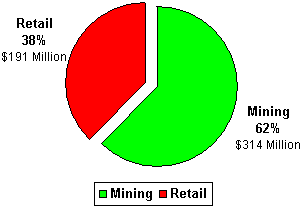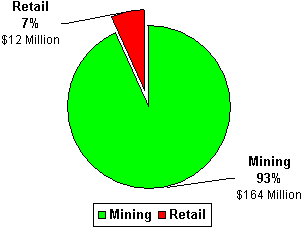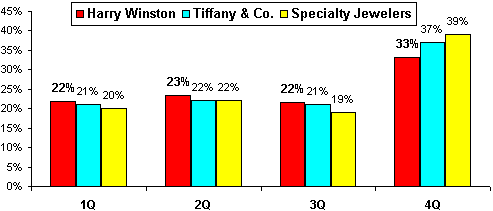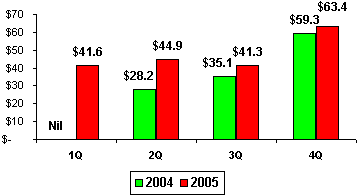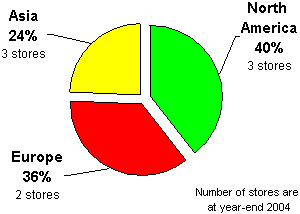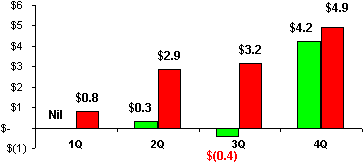IDEX Online Research: Harry Winston is Aber Diamond’s Crown Jewel
April 02, 06
When Aber Diamond announced that it had taken a majority ownership position in Harry Winston Jewelers, many in the diamond industry did not understand why a mining company would purchase a retailer. After all, the culture of mining companies is very different from the culture of retailing.
As Aber Diamond chairman Bob Gannicott explained it, Aber’s strategy is to “book-end” the diamond industry. Aber wanted a significant presence in mining (upstream) and retailing (downstream), but really wanted nothing to do with the business between the two. Why? Gannicott also has a reputation for “following the money.” And there’s little money – certainly only very modest profits – in the diamond pipeline between mining and retailing.
Aber Diamond: Mining and Retailing
Aber Diamond’s revenues come from two sources: mining and retail. “Retail” revenues are from its controlling interest in Harry Winston. Aber’s current ownership of Harry Winston has increased modestly to 52.83 percent from its original 51.0 percent in April 2004.
Just under 2/3 of Aber Diamond’s revenues come from its mining ventures, and slightly over 1/3 come from Harry Winston. However, operating profits from Harry Winston represent only about 7 percent of total corporate operating profits. The graphs below summarize revenue and profit contribution by operating division.
| Aber Diamond Revenue Sources 2005 Total Revenues $505 Million
| Aber Diamond Operating Profit Sources |
The disparity in operating profits between mining and retail is typical. Mining is a capital intensive business; Aber’s profits represent a reasonable return on the capital invested in that portion of its business. In contrast, retailing is not a capital intensive business. Thus, the stream of profits that Aber derives from Harry Winston correlates to its capital investment in the business. Harry Winston’s operating margin is currently at the low end of a range for similar jewelers; management is focused on improving its operating margin.
Harry Winston Sales: Not As Seasonal As Most Jewelers
Compared to other jewelers, Harry Winston’s sales are less seasonal, as the graph below illustrates. This allows the company to post a profit in every quarter of the year; most jewelers post a profit only in the fourth calendar quarter.
| Seasonality of Sales |
2005: A Strong Year for Harry Winston
Sales – Up 22 percent (comparable basis) – Aber Diamond purchased a controlling interest in Harry Winston in April 2004. On a reported basis, sales were up 44 percent year-over-year 2005 vs. 2004. On a twelve-month comparable basis (full year 2005 vs. full year 2004, including the portion of the year prior to Aber’s investment in Harry Winston), retail sales rose a very strong 22 percent.
The graph below illustrates Harry Winston’s revenues by quarter for both calendar 2004 and calendar 2005.
| Harry Winston Revenues |
In our opinion, this strong sales performance was driven by several factors, including the following:
1. New management team
2. New design and product initiatives
3. Revitalization of existing stores
4. New marketing initiatives
5. New store openings, with a new prototype store concept
6. Strong global demand for luxury diamonds and jewelry
Aber management also mentioned specific initiatives, including new diamond jewelry product at price points under $20,000. In the fourth quarter, Harry Winston focused on sales of high-end jewelry and watches, and supplemented these promotions with a newspaper campaign that highlighted unique Harry Winston diamond jewelry in the under-$75,000 range. Several sources list Harry Winston’s average ticket in the $50,000 to $100,000 range. While the company has historically positioned itself as a purveyor of luxury jewelry through one of a kind, high-end diamond pieces, especially in bridal jewelry, our sense is that Harry Winston may be shedding some of its exclusive aura in favor of a more approachable image. Its current entry level price point is about $4,000.
While management has not yet disclosed sales performance by geographic divisions for 2005, it said that sales were flattish in Europe, while showing solid gains in the U.S. and Asia. The graph below summarizes revenues by geographic division for 2004 (fiscal year ended January 2005).
| Harry Winston Sales by Geography |
Solid Gross Margin – 51.1 percent vs. 47.3 percent – A shift in Harry Winston’s sales mix toward high margin items in its newly refined merchandise mix helped push the company’s gross margin beyond its goal of about 50 percent.
Several factors drove higher margins, including the following:
1. Product mix refinement
2. More efficient sourcing of product
3. Jewelry manufacturing refinement
Longer term, management expects Harry Winston’s gross margin to settle in around 50 percent.
By comparison, Tiffany’s gross margin is in the 56-58 percent range due in part to a greater sales mix of lower-priced jewelry, which carries an inherently higher margin. Tiffany is also highly vertically integrated; thus, it keeps manufacturing profits for itself. Birks, which operates high-end jewelry stores in Canada, generates a gross margin in the 50-51 percent range. Most mass market jewelers operate with a gross margin in the 44-48 percent range.
Reasonable Operating Expenses – 44.9 percent vs. 43.9 percent – The company has continued to spend heavily on personnel and control infrastructure to support its sales growth objectives. Most luxury retailers’ expense ratios are in the 42 percent-50 percent range. Thus, Harry Winston’s expense ratio remains at the lower end of this range.
Several factors drove operating costs higher, including the following:
1. Higher salaries and benefits
2. Higher rent and building related costs
3. Higher allowance for doubtful accounts (customer bad debts)
In the fourth quarter, Harry Winston spent less on advertising and selling. We believe, however, that while the “net” cost of advertising declined modestly, it is possible that the company accepted co-operative advertising contributions from some suppliers.
Longer term, as Harry Winston’s store base expands and matures, we expect that its operating cost ratio will decline modestly.
By comparison, Tiffany’s operating cost ratio is in the 40-42 percent range. This is due to the relative maturity of its stores and strong same-store sales, which help to efficiently absorb fixed overhead costs. Birks (of Canada) has an operating cost ratio in the 44-45 percent range.
Operating Margin – 6.2 percent vs. 3.4 percent – For the full fiscal year ended January 2006, Harry Winston posted an operating margin of 6.2 percent. This was almost double the prior year’s margin of 3.4 percent. Management said its long term goal is to approach a 10 percent operating margin.
| Harry Winston Operating Profits |
New Store Openings – +25 percent in 2005 – At the beginning of 2005, Harry Winston had eight stores. During the year, it opened two units – Bal Harbour (Florida) and Ala Moana (Hawaii). It also relocated its Beverly Hills (California) store to a 6,000 square foot unit, replacing a much smaller store that was further north on Rodeo Drive in Beverly Hills.
This year (2006), we expect the company to open about three new units. It has already opened a new store (mid-March) in Tokyo in the Omotesando district. A new store is slated to open in London, and a new unit is planned for Beijing. In 2007, a store is planned for Chicago. Its current store in Osaka, Japan, will be relocated to a larger store in 2007. Management said it is possible that another new unit will be opened in 2007. It expects new store growth in the range of 15-20 percent for the next three years.
Longer term, management has identified about 60 global markets that could support a Harry Winston store. By 2011, management has a goal of operating 25 stores, up from ten units at the end of 2005.
At the end of the year, Harry Winston operated ten stores in the following markets: New York, Ala Moana, Bal Harbour, Beverly Hills, Las Vegas, Paris, Geneva, Tokyo, Osaka, and Taipei. Harry Winston timepieces are also sold through a network of independent distributors.
Other Comments
1. Brand equity – Management has approached the Harry Winston acquisition with a very different culture than its mining ventures. Unlike mining which has no residual value when there are no more diamonds, a retail operation builds residual value – often called brand equity. Brand equity is not shown on the balance sheet until it is unlocked and valued in an acquisition. However, it can often be a substantial value.
2. Growth opportunities – Despite its success with Harry Winston, Aber management said it is focused on growth opportunities in its mining division. Two reasons were cited: 1) the company already owns “the best name in the business,” according to Aber chairman Bob Gannicott; and 2) as Aber grows, it will have more strength in the diamond market as it adds supply, especially of better quality stones.
3. Diamond sources – Aber recently opened an office in India, and it plans to open an office in Israel. This will allow Harry Winston to source diamonds from key supply markets.
